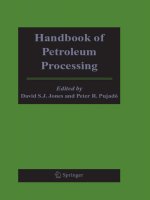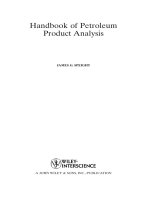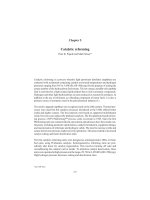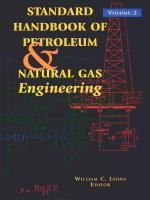handbook of petroleum product analysis
Bạn đang xem bản rút gọn của tài liệu. Xem và tải ngay bản đầy đủ của tài liệu tại đây (5.74 MB, 461 trang )
Handbook of Petroleum
Product Analysis
JAMES G. SPEIGHT
A JOHN WILEY & SONS, INC., PUBLICATION
Copyright © 2002 by John Wiley & Sons, Inc. All rights reserved.
Published by John Wiley & Sons, Inc., Hoboken, New Jersey.
Published simultaneously in Canada.
No part of this publication may be reproduced, stored in a retrieval system, or transmitted
in any form or by any means, electronic, mechanical, photocopying, recording, scanning, or
otherwise, except as permitted under Section 107 or 108 of the 1976 United States
Copyright Act, without either the prior written permission of the Publisher, or authorization
through payment of the appropriate per-copy fee to the Copyright Clearance Center, Inc.,
222 Rosewood Drive, Danvers, MA 01923, 978-750-8400, fax 978-750-4470, or on the web at
www.copyright.com. Requests to the Publisher for permission should be addressed to the
Permissions Department, John Wiley & Sons, Inc., 111 River Street, Hoboken, NJ 07030,
(201) 748-6011, fax (201) 748-6008, e-mail:
Limit of Liability/Disclaimer of Warranty: While the publisher and author have used their
best efforts in preparing this book, they make no representations or warranties with respect
to the accuracy or completeness of the contents of this book and specifically disclaim any
implied warranties of merchantability or fitness for a particular purpose. No warranty may
be created or extended by sales representatives or written sales materials. The advice and
strategies contained herein may not be suitable for your situation. You should consult with a
professional where appropriate. Neither the publisher nor author shall be liable for any loss
of profit or any other commercial damages, including but not limited to special, incidental,
consequential, or other damages.
For general information on our other products and services please contact our Customer
Care Department within the U.S. at 877-762-2974, outside the U.S. at 317-572-3993 or fax
317-572-4002.
Wiley also publishes its books in a variety of electronic formats. Some content that appears
in print, however, may not be available in electronic format.
Library of Congress Cataloging-in-Publication Data is available:
ISBN: 0-471-20346-7
Printed in the United States of America
10987654321
PREFACE
This book complements the book Handbook of Petroleum Analysis (J.G.
Speight, John Wiley & Sons, 2001), and it is the purpose of these books to
make available, in two handy volumes the essential elements of all analyt-
ical tests used to characterize petroleum and petroleum products.
It is, of course, critical for testing laboratory personnel to be fully familiar
with all the details of the tests they are performing. But it is also important
for nonlaboratory personnel to know at least the significance, advantages,
and limitations of particular tests used to characterize product quality. Both
the suppliers and the customers need to agree on the appropriate product
quality specifications, and this can be achieved by understanding the intri-
cacies of the respective test methods.
Product specifications not based on realistic testing capabilities can only
lead to quality complaints and unhappiness on the part of both suppliers
and customers. Therefore, we expect that this book will prove useful not
only to laboratory personnel but also to product specification writers,
process engineers, process scientists, researchers, and marketing staff in
understanding the importance of these tests as well as their limitations, so
that sound conclusions can be reached regarding the quality and perfor-
mance of a particular product.
Organizations such as the American Society for Testing and Materials
(ASTM) in the United States, the Institute of Petroleum (IP, London, U.K.),
the Association Française de Normalisation (AFNOR, Paris, France),
the Deutsche Institut für Normung (DIN, Germany), the Japan Industrial
Standards (JIS, Tokyo, Japan), and the International Organization for
Standardization (ISO, Geneva, Switzerland) have made significant contri-
butions in developing standard test methods for the analyses of petroleum
products. Although it is not possible to include all of the test methods of
these organizations, cross-reference is made of the standard methods of
analysis of the ASTM to those that are known for the IP.
In addition, the ASTM has discontinued several of the tests cited in the
text for testing and materials, but they are included here because of their
continued use by analytical laboratories. Several tests may even have been
modified for internal company use, and there is no way of authenticating
such use. Indeed, many tests should be adopted for internal company use
xv
instead of existing in-house testing protocols. For example, one might read
in the published literature of the use of modified naphtha to precipitate an
asphaltene fraction. Such a statement is meaningless without precise defi-
nition of the chemical composition of the modified naphtha. Naphtha is
a complex petroleum product that can vary depending on the method of
production. So, without any qualification or chemical description of the
modified naphtha, a comparison of the precipitate with a pentane-asphaltene
or heptane-asphaltene will be futile. Indeed, cross-comparisons within the
in-house laboratories may be difficult if not impossible. The moral of this
tale is that testing protocols should be standardized!
It is not intented that this book should replace the Annual Book of ASTM
Standards. This book is intended to be a complementary volume that con-
tains explanations of the raison d’être of the various test methods.
Each chapter is written as a stand-alone unit, which has necessitated some
repetition. This repetition is considered necessary for the reader to have
all of the relevant information at hand, especially where there are tests
that can be applied to several products. Where this is not possible, cross-
references to the pertinent chapter(s) are included. Several general refer-
ences are listed for the reader to consult for a more detailed description
of petroleum products. No attempt has been made to be exhaustive in the
citations of such works. Thereafter, the focus is to cite the relevant test
methods that are applied to petroleum products.
Finally, in this book, no preference is given to any particular tests.All lists
of tests are alphabetical.
Dr.James G. Speight
Laramie, Wyoming
xvi preface
v
This page has been reformatted by Knovel to provide easier navigation.
Contents
Preface xv
1. Petroleum Analysis 1
1.1 Introduction 1
1.2 Definitions 6
1.3 Historical Perspectives 10
1.4 Modern Perspectives 12
1.5 Analysis and Specifications 13
1.6 Sampling 17
1.7 Measurement 20
1.8 Accuracy 22
1.9 Precision 23
1.10 Method Validation 24
References 26
2. Petroleum and Petroleum Products 29
2.1 Petroleum 29
2.1.1 Definitions 30
2.1.2 Composition 33
2.2 Petroleum Assay 34
2.2.1 Carbon Residue, Asphaltene Content 35
2.2.2 Density (Specific Gravity) 37
2.2.3 Distillation 39
vi Contents
This page has been reformatted by Knovel to provide easier navigation.
2.2.4 Light Hydrocarbons 41
2.2.5 Metallic Constituents 41
2.2.6 Salt Content 42
2.2.7 Sulfur Content 43
2.2.8 Viscosity and Pour Point 45
2.2.9 Water and Sediment 47
2.2.10 Wax Content 48
2.2.11
Other Tests
49
2.3 Petroleum Refining 51
2.3.1 Visbreaking 53
2.3.2 Coking 54
2.3.3 Hydroprocessing 56
2.4 Natural Gas 57
2.4.1 Definition 57
2.4.2 Composition 58
2.4.3 Properties and Test Methods 61
2.5 Natural Gas Liquids and Natural Gasoline 62
2.6 Petroleum Character and Behavior 63
References 66
3. Gases 69
3.1 Introduction 69
3.1.1 Liquefied Petroleum Gas 69
3.1.2 Natural Gas 71
3.1.3 Refinery Gas 74
3.2 Sampling 75
3.3 Properties and Test Methods 76
3.3.1 Calorific Value (Heat of Combustion) 76
3.3.2 Composition 77
3.3.3 Density 82
Contents vii
This page has been reformatted by Knovel to provide easier navigation.
3.3.4 Sulfur 82
3.3.5 Volatility and Vapor Pressure 83
3.3.6 Water 83
References 83
4. Naphtha 85
4.1 Introduction 85
4.2 Production and Properties 86
4.3 Test Methods 88
4.3.1 Aniline Point and Mixed Aniline Point 90
4.3.2 Composition 90
4.3.3 Correlative Methods 96
4.3.4 Density (Specific Gravity) 97
4.3.5 Evaporation Rate 98
4.3.6 Flash Point 99
4.3.7 Kauri-Butanol Value 100
4.3.8 Odor and Color 100
4.3.9 Volatility 101
References 103
5. Gasoline 105
5.1 Introduction 105
5.2 Production and Properties 105
5.3 Test Methods 109
5.3.1 Additives 109
5.3.2 Combustion Characteristics 112
5.3.3 Composition 114
5.3.4 Corrosiveness 118
5.3.5 Density (Specific Gravity) 120
5.3.6 Flash Point and Fire Point 121
viii Contents
This page has been reformatted by Knovel to provide easier navigation.
5.3.7 Oxygenates 123
5.3.8 Stability and Instability 123
5.3.9 Volatility 127
5.3.10 Water and Sediment 132
References 134
6. Aviation Fuel 137
6.1 Introduction 137
6.2 Production and Properties 138
6.3 Test Methods 139
6.3.1 Acidity 139
6.3.2 Additives 140
6.3.3 Calorific Value (Heat of Combustion) 141
6.3.4 Composition 143
6.3.5 Density (Specific Gravity) 147
6.3.6 Flash Point 147
6.3.7 Freezing Point 148
6.3.8 Knock and Antiknock Properties 149
6.3.9 Pour Point 150
6.3.10 Storage Stability 150
6.3.11 Thermal Stability 151
6.3.12 Viscosity 152
6.3.13 Volatility 152
6.3.14 Water 154
References 155
7. Kerosene 157
7.1 Introduction 157
7.2 Production and Properties 157
Contents ix
This page has been reformatted by Knovel to provide easier navigation.
7.3 Test Methods 160
7.3.1 Acidity 161
7.3.2 Burning Characteristics 161
7.3.3 Calorific Value (Heat of Combustion) 163
7.3.4 Composition 164
7.3.5 Density (Specific Gravity) 169
7.3.6 Flash Point 170
7.3.7 Freezing Point 170
7.3.8 Pour Point 171
7.3.9 Smoke Point 172
7.3.10 Viscosity 172
7.3.11 Volatility 173
7.3.12 Water and Sediment 174
References 175
8. Diesel Fuel 177
8.1 Introduction 177
8.2 Production and Properties 177
8.3 Test Methods 178
8.3.1 Acidity 179
8.3.2 Appearance and Odor 179
8.3.3 Ash 179
8.3.4 Calorific Value (Heat of Combustion) 180
8.3.5 Carbon Residue 181
8.3.6 Cetane Number and Cetane Index 182
8.3.7 Cloud Point 184
8.3.8 Composition 184
8.3.9 Density (Specific Gravity) 188
8.3.10 Diesel Index 189
8.3.11 Flash Point 189
x Contents
This page has been reformatted by Knovel to provide easier navigation.
8.3.12 Freezing Point 190
8.3.13 Neutralization Number 191
8.3.14 Pour Point 191
8.3.15 Stability 192
8.3.16 Viscosity 193
8.3.17 Volatility 194
8.3.18 Water and Sediment 195
References 196
9. Distillate Fuel Oil 197
9.1 Introduction 197
9.2 Production and Properties 199
9.3 Test Methods 200
9.3.1 Acidity 200
9.3.2 Ash Content 201
9.3.3 Calorific Value (Heat of Combustion) 202
9.3.4 Carbon Residue 203
9.3.5 Cloud Point 204
9.3.6 Composition 204
9.3.7 Density (Specific Gravity) 207
9.3.8 Flash Point 207
9.3.9 Metallic Constituents 207
9.3.10 Pour Point 208
9.3.11 Stability 210
9.3.12 Viscosity 212
9.3.13 Volatility 213
9.3.14 Water and Sediment 215
References 215
Contents xi
This page has been reformatted by Knovel to provide easier navigation.
10. Residual Fuel Oil 217
10.1 Introduction 217
10.2 Production and Properties 218
10.3 Test Methods 219
10.3.1 Ash 219
10.3.2 Asphaltene Content 220
10.3.3 Calorific Value (Heat of Combustion) 221
10.3.4 Carbon Residue 222
10.3.5 Composition 224
10.3.6 Density (Specific Gravity) 230
10.3.7 Elemental Analysis 231
10.3.8 Flash Point 234
10.3.9 Metals Content 234
10.3.10 Molecular Weight 236
10.3.11 Pour Point 237
10.3.12 Refractive Index 237
10.3.13 Stability 238
10.3.14 Viscosity 239
10.3.15 Volatility 240
10.3.16 Water 243
References 244
11. Mineral Oil (White Oil) 247
11.1 Introduction 247
11.2 Production and Properties 247
11.3 Test Methods 249
11.3.1 Acidity or Alkalinity 250
11.3.2 Aniline Point 252
11.3.3 Asphaltene Content (Insoluble
Constituents) 252
xii Contents
This page has been reformatted by Knovel to provide easier navigation.
11.3.4 Carbonizable Substances (Acid Test) 253
11.3.5 Carbon Residue 254
11.3.6 Cloud Point 255
11.3.7 Color and Taste 256
11.3.8 Composition 257
11.3.9 Density (Specific Gravity) 259
11.3.10 Electrical Properties 260
11.3.11 Flash Point and Fire Point 260
11.3.12 Interfacial Tension 261
11.3.13 Iodine Value 262
11.3.14 Oxidation Stability 262
11.3.15 Pour Point 263
11.3.16 Refractive Index 264
11.3.17 Smoke Point 264
11.3.18 Specific Optical Dispersion 264
11.3.19 Ultraviolet Absorption 265
11.3.20 Viscosity 265
11.3.21 Volatility 266
11.3.22 Water 266
11.3.23 Wax Appearance Point 266
References 267
12. Lubricating Oil 269
12.1 Introduction 269
12.2 Production and Properties 269
12.3 Test Methods 273
12.3.1 Acidity and Alkalinity 273
12.3.2 Ash 274
12.3.3 Asphaltene Content (Insoluble
Constituents) 274
Contents xiii
This page has been reformatted by Knovel to provide easier navigation.
12.3.4 Carbonizable Substances (Acid Test) 276
12.3.5 Carbon Residue 277
12.3.6 Cloud Point 278
12.3.7 Color 278
12.3.8 Composition 279
12.3.9 Density (Specific Gravity) 282
12.3.10 Flash Point and Fire Point 283
12.3.11 Oxidation Stability 283
12.3.12 Pour Point 284
12.3.13 Thermal Stability 284
12.3.14 Viscosity 285
12.3.15 Volatility 286
12.3.16 Water and Sediment 287
References 288
13. Grease 291
13.1 Introduction 291
13.2 Production and Properties 291
13.3 Test Methods 295
13.3.1 Acidity and Alkalinity 295
13.3.2 Anticorrosion Properties 296
13.3.3 Composition 296
13.3.4 Dropping Point 297
13.3.5 Flow Properties 298
13.3.6 Low-Temperature Torque 299
13.3.7 Mechanical Stability 299
13.3.8 Oil Separation 300
13.3.9 Oxidation Stability 301
13.3.10 Penetration 302
13.3.11 Thermal Stability 302
xiv Contents
This page has been reformatted by Knovel to provide easier navigation.
13.3.12 Viscosity 303
13.3.13 Volatility 303
13.3.14 Water Resistance 304
References 304
14. Wax 307
14.1 Introduction 307
14.2 Production and Properties 308
14.3 Test Methods 309
14.3.1 Appearance 309
14.3.2 Barrier Properties 310
14.3.3 Carbonizable Substances 311
14.3.4 Color 311
14.3.5 Composition 312
14.3.6 Density (Specific Gravity) 313
14.3.7 Hardness 314
14.3.8 Melting Point 314
14.3.9 Molecular Weight 316
14.3.10 Odor and Taste 317
14.3.11 Oil Content 317
14.3.12 Peroxide Content 318
14.3.13 Slip Properties 318
14.3.14 Storage Stability 319
14.3.15 Strength 319
14.3.16 Ultraviolet Absorptivity 320
14.3.17 Viscosity 320
14.3.18 Volatility 321
References 321
Contents xv
This page has been reformatted by Knovel to provide easier navigation.
15. Asphalt 323
15.1 Introduction 323
15.2 Production and Properties 323
15.3 Test Methods 328
15.3.1 Acid Number 328
15.3.2 Asphaltene Content 331
15.3.3 Bonding and Adhesion 333
15.3.4 Breaking Point (Fraas) 333
15.3.5 Carbon Disulfide-Insoluble Constituents 333
15.3.6 Carbon Residue 334
15.3.7 Compatibility 336
15.3.8 Composition 336
15.3.9 Density (Specific Gravity) 338
15.3.10 Distillation 340
15.3.11 Ductility 341
15.3.12 Durability 341
15.3.13 Elemental Analysis 341
15.3.14 Emulsified Asphalt 342
15.3.15 Flash Point 342
15.3.16 Float Test 343
15.3.17 Molecular Weight 343
15.3.18 Penetration 344
15.3.19 Rheology 345
15.3.20 Softening Point 346
15.3.21 Stain 346
15.3.22 Temperature-Volume Correction 347
15.3.23 Thin Film Oven Test 347
15.3.24 Viscosity 347
15.3.25 Water Content 347
xvi Contents
This page has been reformatted by Knovel to provide easier navigation.
15.3.26 Weathering 348
References 348
16. Coke 351
16.1 Introduction 351
16.2 Production and Properties 351
16.3 Test Methods 353
16.3.1 Ash 353
16.3.2 Calorific Value (Heat of Combustion) 354
16.3.3 Composition 355
16.3.4 Density 357
16.3.5 Dust Control Material 357
16.3.6 Hardness 358
16.3.7 Metals 358
16.3.8 Proximate Analysis 359
16.3.9 Sulfur 360
16.3.10 Volatile Matter 361
16.3.11 Water 361
References 362
Conversion Factors 363
Glossary 365
Index 389
CHAPTER
1
PETROLEUM ANALYSIS
1.1. INTRODUCTION
Petroleum, meaning literally “rock oil,” is the term used to describe a myriad
of hydrocarbon-rich fluids that have accumulated in subterranean reser-
voirs. Petroleum (also called crude oil) varies dramatically in color, odor,
and flow properties that reflect the diversity of its origin (Table 1.1).
Petroleum products are any petroleum-based products that can be
obtained by refining (Chapter 2) and comprise refinery gas, ethane, lique-
fied petroleum gas (LPG), naphtha, gasoline, aviation fuel, marine fuel,
kerosene, diesel fuel, distillate fuel oil, residual fuel oil, gas oil, lubricants,
white oil, grease, wax, asphalt, as well as coke. Petrochemical products
(Speight, 1999a) are not included here.
Petroleum products are highly complex chemicals, and considerable
effort is required to characterize their chemical and physical properties with
a high degree of precision and accuracy. Indeed, the analysis of petroleum
products is necessary to determine the properties that can assist in resolv-
ing a process problem as well as the properties that indicate the function
and performance of the product in service.
Crude petroleum and the products obtained therefrom contain a variety
of compounds, usually but not always hydrocarbons. As the number of
carbon atoms in, for example, the paraffin series increases, the complexity
of petroleum mixtures also rapidly increases. Consequently, detailed analy-
sis of the individual constituents of the higher boiling fractions becomes
increasingly difficult, if not impossible.
Additionally, classes (or types) of hydrocarbons were, and still are, deter-
mined based on the capability to isolate them by separation techniques.The
four fractional types into which petroleum is subdivided are paraffins,
olefins, naphthenes, and aromatics (PONA). Paraffinic hydrocarbons
include both normal and branched alkanes, whereas olefins refer to normal
and branched alkenes that contain one or more double or triple carbon-
carbon bonds. Naphthene (not to be confused with naphthalene) is a term
specific to the petroleum industry that refers to the saturated cyclic hydro-
carbons (cycloalkanes). Finally, the term aromatics includes all hydrocar-
bons containing one or more rings of the benzenoid structure.
1
These general definitions of the different fractions are subject to the
many combinations of the hydrocarbon types (Speight, 1999a; Speight,
2001) and the action of the adsorbent or the solvent used in the separation
procedure. For example, a compound containing one benzenoid ring (six
aromatic carbon atoms) that has 12 nonaromatic carbons in alkyl side
chains can be separated as an aromatic compound depending on the adsor-
bent employed.
Although not directly derived from composition, the terms light and
heavy or sweet and sour provide convenient terms for use in descriptions.
For example, light petroleum (often referred to as conventional petroleum)
is usually rich in low-boiling constituents and waxy molecules whereas
heavy petroleum contains greater proportions of higher-boiling, more
aromatic, and heteroatom-containing (N-, O-, S-, and metal containing)
constituents. Heavy oil is more viscous than conventional petroleum and
requires enhanced methods for recovery. Bitumen is near solid or solid and
cannot be recovered by enhanced oil recovery methods.
Conventional (light) petroleum is composed of hydrocarbons together
with smaller amounts of organic compounds of nitrogen, oxygen, and sulfur
and still smaller amounts of compounds containing metallic constituents,
particularly vanadium, nickel, iron, and copper. The processes by which
petroleum was formed dictate that petroleum composition will vary and be
site specific, thus leading to a wide variety of compositional differences.The
term site specific is intended to convey that petroleum composition will be
dependent on regional and local variations in the proportion of the various
precursors that went into the formation of the protopetroleum as well as
2 petroleum analysis
Table 1.1. Illustration of the Variation in Composition (Residuum Content) and
Properties (Specific Gravity and API Gravity) of Petroleum
Crude Oil Specific Gravity API Gravity Residuum > 1000°F
U.S. Domestic
California 0.858 33.4 23.0
Oklahoma 0.816 41.9 20.0
Pennsylvania 0.800 45.4 2.0
Texas 0.827 39.6 15.0
Texas 0.864 32.3 27.9
Foreign
Bahrain 0.861 32.8 26.4
Iran 0.836 37.8 20.8
Iraq 0.844 36.2 23.8
Kuwait 0.860 33.0 31.9
Saudi Arabia 0.840 37.0 27.5
Venezuela 0.950 17.4 33.6
variations in temperature and pressure to which the precursors were
subjected.
Thus the purely hydrocarbon content may be higher than 90% by weight
for paraffinic petroleum and 50% by weight for heavy crude oil and much
lower for tar sand bitumen. The nonhydrocarbon constituents are usually
concentrated in the higher-boiling portions of the crude oil. The carbon and
hydrogen content is approximately constant from crude oil to crude oil even
though the amounts of the various hydrocarbon types and of the individ-
ual isomers may vary widely. Thus the carbon content of various types of
petroleum is usually between 83% and 87% by weight and the hydrogen
content is in the range of 11–14% by weight.
General aspects of petroleum quality (as a refinery feedstock) are
assessed by measurement of physical properties such as relative density
(specific gravity), refractive index, or viscosity, or by empirical tests such as
pour point or oxidation stability that are intended to relate to behavior in
service. In some cases the evaluation may include tests in mechanical rigs
and engines either in the laboratory or under actual operating conditions.
Measurements of bulk properties are generally easy to perform and,
therefore, quick and economical. Several properties may correlate well with
certain compositional characteristics and are widely used as a quick and
inexpensive means to determine those characteristics. The most important
properties of a whole crude oil are its boiling-point distribution, its density
(or API gravity), and its viscosity. The boiling-point distribution, boiling
profile, or distillation assay gives the yield of the various distillation cuts,
and selected properties of the fractions are usually determined (Table 1.2).
It is a prime property in its own right that indicates how much gasoline and
other transportation fuels can be made from petroleum without conversion.
Density and viscosity are measured for secondary reasons.The former helps
to estimate the paraffinic character of the oil, and the latter permits the
assessment of its undesirable residual material that causes resistance to
flow. Boiling-point distribution, density, and viscosity are easily measured
and give a quick first evaluation of petroleum oil. Sulfur content, another
crucial and primary property of a crude oil, is also readily determined.
Certain composite characterization values, calculated from density and
mid-boiling point, correlate better with molecular composition than density
alone (Speight, 2001).
The acceptance of heavy oil and bitumen as refinery feedstocks has
meant that the analytical techniques used for the lighter feedstocks have
had to evolve to produce meaningful data that can be employed to assist
in defining refinery scenarios for processing the feedstocks. In addition,
selection of the most appropriate analytical procedures will aid in the pre-
dictability of feedstock behavior during refining. This same rationale can
also be applied to feedstock behavior during recovery operations. Indeed,
introduction 3
4 petroleum analysis
Table 1.2. Distillation Profile of Petroleum (Leduc, Woodbend, Upper Devonian, Alberta, Canada)
and Selected Properties of the Fractions
Boiling range Wt. % Wt. % Specific API Sulfur Carbon
°C °F Cumulative Gravity Gravity Wt. % Residue
(Conradson)
Whole Crude Oil 100.0 0.828 39.4 0.4 1.5
Fraction*
1 0–50 0–122 2.6 2.6 0.650 86.2
2 50–75 122–167 3.0 5.6 0.674 78.4
3 75–100 167–212 5.2 10.8 0.716 66.1
4 100–125 212–257 6.6 17.4 0.744 58.7
5 125–150 257–302 6.3 23.7 0.763 54.0
6 150–175 302–347 5.5 29.2 0.783 49.2
7 175–200 347–392 5.3 34.5 0.797 46.0
8 200–225 392–437 5.0 39.5 0.812 42.8
9 225–250 437–482 4.7 44.2 0.823 40.4
10 250–275 482–527 6.6 50.8 0.837 37.6
11 <200 <392 5.4 56.2 0.852 34.6
12 200–225 392–437 4.9 61.1 0.861 32.8
13 225–250 437–482 5.2 66.3 0.875 30.2
14 250–275 482–527 2.8 69.1 0.883 28.8
15 275–300 527–572 6.7 75.4 0.892 27.0
Residuum >300 >572 22.6 98.4 0.929 20.8 6.6
Distillation loss 1.6
* Distillation at 765mm Hg then at 40 mm Hg for fractions 11–15.
bitumen, a source of synthetic crude oil, is so different from petroleum
(Speight and Moschopedis, 1979; Speight, 1990, Speight, 1999a, Speight,
2001) that many of the test methods designed for petroleum may need
modification (Wallace, 1988).
Thus knowledge of the composition of petroleum allows the refiner
to optimize the conversion of raw petroleum into high-value products.
Petroleum is now the world’s main source of energy and petrochemical
feedstock. Originally, petroleum was distilled and sold as fractions with
desirable physical properties. Today crude oil is sold in the form of gaso-
line, solvents, diesel and jet fuel, heating oil, lubricant oils, and asphalts, or
it is converted to petrochemical feedstocks such as ethylene, propylene, the
butenes, butadiene, and isoprene. These feedstocks are important, because
they form the basis for, among others, the plastics, elastomer, and artificial
fiber industries. Modern refining uses a sophisticated combination of heat,
catalyst, and hydrogen to rearrange the petroleum molecules into these
products. Conversion processes include coking, hydrocracking, and catalytic
cracking to break large molecules into smaller fractions; hydrotreating to
reduce heteroatoms and aromatics, creating environmentally acceptable
products; and isomerization and reforming to rearrange molecules into
those with high value, e.g., gasoline with a high octane number.
Also, knowledge of the molecular composition of petroleum allows the
environmentalist to consider the biological impact of environmental expo-
sure. Increasingly, petroleum is being produced and transported from
remote areas of the world to refineries located closer to their markets.
Although a minuscule fraction of that oil is released into the environment,
because of the sheer volume involved there is the potential for environ-
mental exposure. Molecular composition is needed not only to identify the
sources of contamination but also to understand the fate and effects of its
potentially hazardous components.
In addition, knowledge of the composition of petroleum allows the
geochemist to answer questions of precursor-product relationships and con-
version mechanisms. Biomarkers, molecules that retain the basic carbon
skeletons of biological compounds from living organisms after losing func-
tional groups through the maturation process, play an important role in such
studies. The distribution of biomarker isomers can not only serve as fin-
gerprints for oil/oil and oil/source correlation (to relate the source and
reservoir) but also give geochemical information on organic source input
(marine, lacustrine, or land-based sources), age, maturity, depositional envi-
ronment (for example, clay or carbonate, oxygen levels, salinity), and alter-
ation (for example, water washing, biodegradation).
The need for the application of analytical techniques has increased over
the past three decades because of the change in feedstock composition.This
has arisen because of the increased amounts of the heavier feedstocks that
introduction 5
are now used to produce liquid products. Before the energy crises of the
1970s, the heavier feedstocks were used infrequently as sources of liquid
fuels and were used to produce asphalt. Now these feedstocks have
increased in value as sources of liquid fuels.
Because of the wide range of chemical and physical properties, a wide
range of tests have been (and continue to be) developed to provide an indi-
cation of the means by which a particular feedstock should be processed.
Initial inspection of the nature of the petroleum will provide deductions
about the most logical means of refining or correlation of various proper-
ties to structural types present and hence attempted classification of the
petroleum. Proper interpretation of the data resulting from the inspection
of crude oil requires an understanding of their significance.
Having decided what characteristics are necessary, it then remains to
describe the product in terms of a specification. This entails selecting suit-
able test methods and setting appropriate limits. Many specifications in
widespread use have evolved usually by the addition of extra clauses (rarely
is a clause deleted). This has resulted in unnecessary restrictions that, in
turn, result in increased cost of the products specified.
1.2. DEFINITIONS
Terminology is the means by which various subjects are named so that
reference can be made in conversations and in writing so that the meaning
is passed on.
Definitions are the means by which scientists and engineers communi-
cate the nature of a material to each other and to the world, through either
the spoken or the written word. Thus the definition of a material can be
extremely important and can have a profound influence on how the tech-
nical community and the public perceive that material.
Historically, physical properties such as boiling point, density (gravity),
odor, and viscosity have been used to describe oils. Petroleum may be called
light or heavy in reference to the amount of low-boiling constituents and
the relative density (specific gravity). Likewise, odor is used to distinguish
between sweet (low sulfur) and sour (high sulfur) crude oil. Viscosity indi-
cates the ease of (or more correctly the resistance to) flow.
However, where there is the need for a thorough understanding of petro-
leum and the associated technologies, it is essential that the definitions and
the terminology of petroleum science and technology be given prime con-
sideration (Speight, 1999a). This presents a better understanding of petro-
leum, its constituents, and its various fractions. Of the many forms of
terminology that have been used not all have survived, but the more com-
6 petroleum analysis
monly used are illustrated here. Particularly troublesome, and more
confusing, are those terms that are applied to the more viscous materials,
for example, the use of the terms bitumen and asphalt. This part of the
text attempts to alleviate much of the confusion that exists, but it must
be remembered that the terminology of petroleum is still open to personal
choice and historical usage.
Petroleum is a naturally occurring mixture of hydrocarbons, generally in
a liquid state, which may also include compounds of sulfur, nitrogen,
oxygen, metals, and other elements (ASTM D-4175, 1998; Speight, 1999a,
1999b and references cited therein).
In the crude state petroleum has minimal value, but when refined it pro-
vides high-value liquid fuels, solvents, lubricants, and many other products
(Purdy, 1957). The fuels derived from petroleum contribute approximately
one-third to one-half of the total world energy supply and are used not only
for transportation fuels (i.e., gasoline, diesel fuel, and aviation fuel, among
others) but also to heat buildings. Petroleum products have a wide variety
of uses that vary from gaseous and liquid fuels to near-solid machinery
lubricants. In addition, the residue of many refinery processes, asphalt—a
once-maligned by-product—is now a premium value product for highway
surfaces, roofing materials, and miscellaneous waterproofing uses.
Crude petroleum is a mixture of compounds boiling at different tem-
peratures that can be separated into a variety of different generic fractions
by distillation (Speight, 1999a, Speight, 2001). The terminology of these
fractions has been bound by utility and often bears little relationship to
composition.
The molecular boundaries of petroleum cover a wide range of boiling
points and carbon numbers of hydrocarbon compounds and other com-
pounds containing nitrogen, oxygen, and sulfur, as well as metallic (por-
phyrin) constituents. However, the actual boundaries of such a petroleum
map can only be arbitrarily defined in terms of boiling point and carbon
number (Fig. 1.1). In fact, petroleum is so diverse that materials from dif-
ferent sources exhibit different boundary limits, and for this reason alone
it is not surprising that petroleum has been difficult to map in a precise
manner (Speight, 2001).
Because there is a wide variation in the properties of crude petroleum,
the proportions in which the different constituents occur vary with origin
(Gruse and Stevens, 1960; Speight, 1999a).Thus some crude oils have higher
proportions of the lower-boiling components and others (such as heavy
oil and bitumen) have higher proportions of higher-boiling components
(asphaltic components and residuum).
There are several other definitions that also must be included in any text
on petroleum analysis, in particular because this text also focuses on the
definitions 7
analysis of heavy oil and bitumen. These definitions are included because
of the increased reliance on the development of these resources and the
appearance of the materials in refineries.
Heavy oil (heavy crude oil) is more viscous than conventional crude oil
and has a lower mobility in the reservoir but can be recovered through a
well from the reservoir by the application of secondary or enhanced recov-
ery methods. On the other hand, tar sand includes the several rock types
that contain an extremely viscous hydrocarbonaceous material that is not
recoverable in its natural state by conventional oil well production methods
including currently used enhanced recovery techniques.
More descriptively, tar sand is an unconsolidated-to-consolidated sand-
stone or a porous carbonate rock, impregnated with bitumen. In simple
terms, an unconsolidated rock approximates the consistency of dry or moist
sand, and a consolidated rock may approximate the consistency of set con-
crete. Alternative names, such as bituminous sand or (in Canada) oil sand,
are gradually finding usage, with the former name more technically correct.
The term oil sand is also used in the same way as the term tar sand, and the
terms are used interchangeably. The term oil sand is analogous to the term
oil shale. Neither material contains oil, but oil is produced therefrom by
application of thermal decomposition methods. It is important to under-
stand that tar sand and the bitumen contained therein are different com-
ponents of the deposit. The recovery of the bitumen, a hydrocarbonaceous
material that can be converted into synthetic crude oil (Speight, 1990,
8 petroleum analysis
Figure 1.1. Boiling point-carbon number profile for petroleum
Speight, 1999a), depends to a large degree on the composition and con-
struction of the sands.
It should be noted here that to be chemically correct, it must be recog-
nized that hydrocarbon molecules only contain carbon atoms and hydro-
gen atoms. The molecular constituents found in tar sand bitumen also
contain nitrogen, oxygen, sulfur, and metals (particularly nickel and vana-
dium) chemically bound in their molecular structures. Thus it is chemically
correct to refer to bitumen as a hydrocarbonaceous material, that is, a mate-
rial that is composed predominantly of carbon and hydrogen, while recog-
nizing the presence of the other atoms.
The term bitumen (also, on occasion, referred to as native asphalt and
extra heavy oil) includes a wide variety of reddish-brown to black materi-
als of semisolid, viscous to brittle character that can exist in nature with no
mineral impurity or with mineral matter contents that exceed 50% by
weight. Bitumen is frequently found filling pores and crevices of sandstone,
limestone, or argillaceous sediments, in which case the organic and associ-
ated mineral matrix is known as rock asphalt.
On the basis of the definition of tar sand (above), bitumen is a naturally
occurring hydrocarbonaceous material that has little or no mobility under
reservoir conditions and which cannot be recovered through a well by con-
ventional oil well production methods including currently used enhanced
recovery techniques; current methods for bitumen recovery involve mining
(Speight, 1990).
Because of the immobility of the bitumen, the permeability of the
deposit is low and passage of fluids through the deposit is prevented.
Bitumen is a high-boiling material with little, if any, material boiling below
350°C (660°F), and the boiling range approximates the boiling range of
an atmospheric residuum and has a much lower proportion of volatile
constituents than a conventional crude oil (Speight, 1999a, Speight,
2001).
Synthetic crude oil is the hydrocarbon liquid that is produced from
bitumen, by a variety of processes that involve thermal decomposition.
Synthetic crude oil (also referred to as syncrude) is a marketable and trans-
portable product that resembles conventional crude oil. Synthetic crude oil,
although it may be produced from one of the less conventional fossil fuel
sources, can be accepted into and refined by the usual refinery system.
For the purposes of terminology, it is preferable to subdivide petroleum
and related materials into three major subgroups (Table 1.3; Speight, 1999a):
1. Materials that are of natural origin;
2. Materials that are manufactured; and
3. Materials that are integral fractions derived from the natural or
manufactured products.
definitions 9









